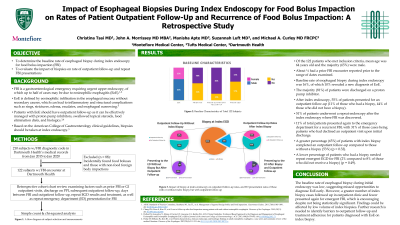Back


Poster Session A - Sunday Afternoon
Category: Esophagus
A0196 - Impact of Esophageal Biopsies During Index Endoscopy for Food Bolus Impaction on Rates of Patient Outpatient Follow-Up and Recurrence of Food Bolus Impaction: A Retrospective Study
Sunday, October 23, 2022
5:00 PM – 7:00 PM ET
Location: Crown Ballroom

Has Audio

Christina Tsai, MD
Montefiore Medical Center
Bronx, NY
Presenting Author(s)
Christina Tsai, MD1, John A. Morrissey, MD, MBA2, Manisha Apte, MD3, Suzannah Luft, MD3, Michael A. Curley, MD4
1Montefiore Medical Center, Bronx, NY; 2Tufts Medical Center, Boston, MA; 3Dartmouth-Hitchcock Medical Center, Lebanon, NH; 4Dartmouth Health, Lebanon, NH
Introduction: Food bolus impaction (FBI) is a gastroenterological emergency requiring urgent upper endoscopy, of which up to half of cases may be due to eosinophilic esophagitis (EoE). EoE is defined by eosinophilic infiltration in the esophageal mucosa without secondary causes, which can lead to inflammatory and structural complications. Patients with EoE should have outpatient follow up as it can be effectively managed with proton pump inhibitors, swallowed topical steroids, and food elimination diets. This study aims to determine baseline rate of esophageal biopsy during index endoscopy for FBI, as recommended by American College of Gastroenterology clinical guidelines, and evaluate the impact of biopsies on rate of outpatient follow-up and repeat FBI presentations.
Methods: This retrospective cohort chart review study evaluated patients over age 18 who presented with acute FBI at Dartmouth-Hitchcock Medical Center from 2015 to 2020. Patients with incidentally found food boluses and with non-food foreign body impactions were excluded. Simple count and chi-squared analyses were performed, with a p-value < 0.05 indicating significance.
Results: 122 patients met inclusion criteria, with a mean age of 64 years old and 65% being male. Approximately half had a prior FBI though only 20% had a previous outpatient gastroenterology appointment. Baseline rate of esophageal biopsy during index endoscopy was 16%, of which 10% revealed a new diagnosis of EoE. After index endoscopy, 55% presented for outpatient follow-up and 51% underwent repeat endoscopy. 11% presented again to the emergency department for a recurrent FBI, with 31% of those patients having previously declined an outpatient visit. A greater percentage (65%) of patients with index biopsy completed an outpatient follow-up compared to those without a biopsy (53%) (p=0.32). There was minimal difference between those who had a biopsy and presented again with emergent FBI (15%) compared to those without a biopsy who re-presented (10%) (p=0.49).
Discussion: The baseline rate of esophageal biopsy during initial endoscopy was low, suggesting missed opportunities to diagnose EoE early. A greater number of index biopsy cases followed up in outpatient clinic, though was not statistically significant. Findings could be affected by low volume of index biopsies. Further research is needed to identify barriers to outpatient follow-up and treatment adherence for patients diagnosed with EoE on index biopsy.
Disclosures:
Christina Tsai, MD1, John A. Morrissey, MD, MBA2, Manisha Apte, MD3, Suzannah Luft, MD3, Michael A. Curley, MD4. A0196 - Impact of Esophageal Biopsies During Index Endoscopy for Food Bolus Impaction on Rates of Patient Outpatient Follow-Up and Recurrence of Food Bolus Impaction: A Retrospective Study, ACG 2022 Annual Scientific Meeting Abstracts. Charlotte, NC: American College of Gastroenterology.
1Montefiore Medical Center, Bronx, NY; 2Tufts Medical Center, Boston, MA; 3Dartmouth-Hitchcock Medical Center, Lebanon, NH; 4Dartmouth Health, Lebanon, NH
Introduction: Food bolus impaction (FBI) is a gastroenterological emergency requiring urgent upper endoscopy, of which up to half of cases may be due to eosinophilic esophagitis (EoE). EoE is defined by eosinophilic infiltration in the esophageal mucosa without secondary causes, which can lead to inflammatory and structural complications. Patients with EoE should have outpatient follow up as it can be effectively managed with proton pump inhibitors, swallowed topical steroids, and food elimination diets. This study aims to determine baseline rate of esophageal biopsy during index endoscopy for FBI, as recommended by American College of Gastroenterology clinical guidelines, and evaluate the impact of biopsies on rate of outpatient follow-up and repeat FBI presentations.
Methods: This retrospective cohort chart review study evaluated patients over age 18 who presented with acute FBI at Dartmouth-Hitchcock Medical Center from 2015 to 2020. Patients with incidentally found food boluses and with non-food foreign body impactions were excluded. Simple count and chi-squared analyses were performed, with a p-value < 0.05 indicating significance.
Results: 122 patients met inclusion criteria, with a mean age of 64 years old and 65% being male. Approximately half had a prior FBI though only 20% had a previous outpatient gastroenterology appointment. Baseline rate of esophageal biopsy during index endoscopy was 16%, of which 10% revealed a new diagnosis of EoE. After index endoscopy, 55% presented for outpatient follow-up and 51% underwent repeat endoscopy. 11% presented again to the emergency department for a recurrent FBI, with 31% of those patients having previously declined an outpatient visit. A greater percentage (65%) of patients with index biopsy completed an outpatient follow-up compared to those without a biopsy (53%) (p=0.32). There was minimal difference between those who had a biopsy and presented again with emergent FBI (15%) compared to those without a biopsy who re-presented (10%) (p=0.49).
Discussion: The baseline rate of esophageal biopsy during initial endoscopy was low, suggesting missed opportunities to diagnose EoE early. A greater number of index biopsy cases followed up in outpatient clinic, though was not statistically significant. Findings could be affected by low volume of index biopsies. Further research is needed to identify barriers to outpatient follow-up and treatment adherence for patients diagnosed with EoE on index biopsy.
Disclosures:
Christina Tsai indicated no relevant financial relationships.
John Morrissey indicated no relevant financial relationships.
Manisha Apte indicated no relevant financial relationships.
Suzannah Luft indicated no relevant financial relationships.
Michael Curley indicated no relevant financial relationships.
Christina Tsai, MD1, John A. Morrissey, MD, MBA2, Manisha Apte, MD3, Suzannah Luft, MD3, Michael A. Curley, MD4. A0196 - Impact of Esophageal Biopsies During Index Endoscopy for Food Bolus Impaction on Rates of Patient Outpatient Follow-Up and Recurrence of Food Bolus Impaction: A Retrospective Study, ACG 2022 Annual Scientific Meeting Abstracts. Charlotte, NC: American College of Gastroenterology.
